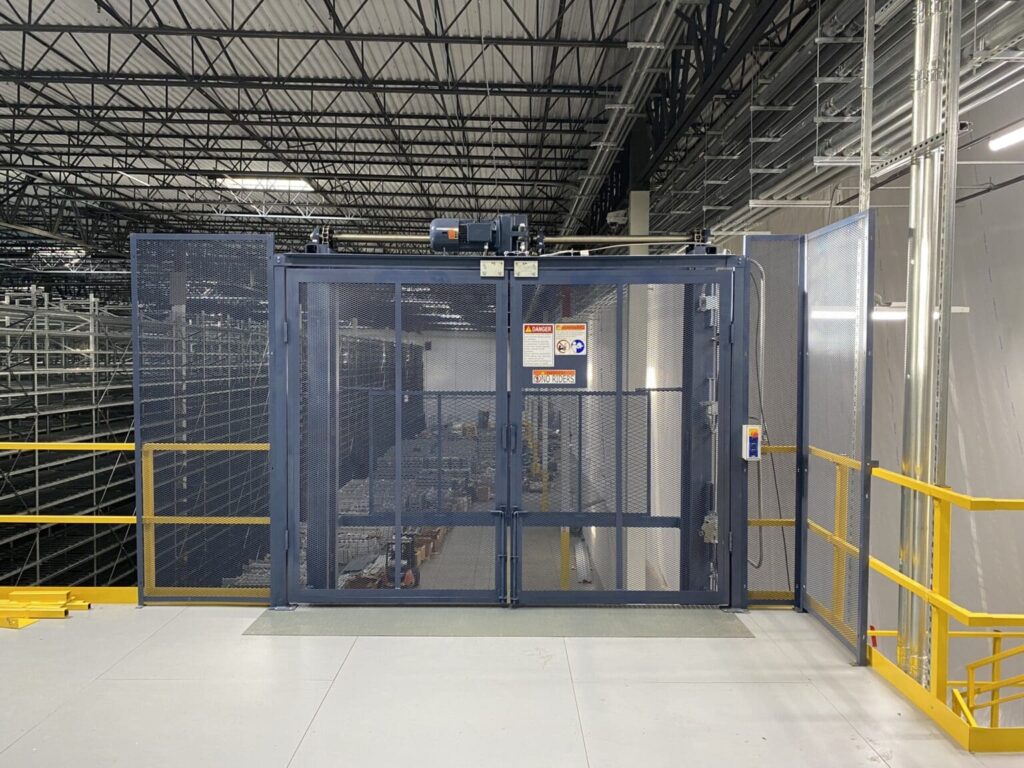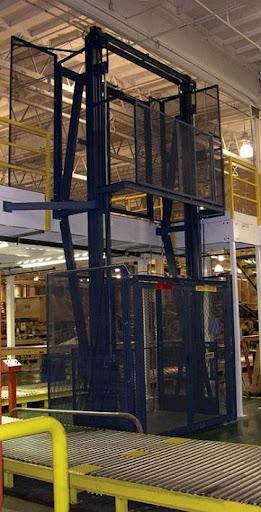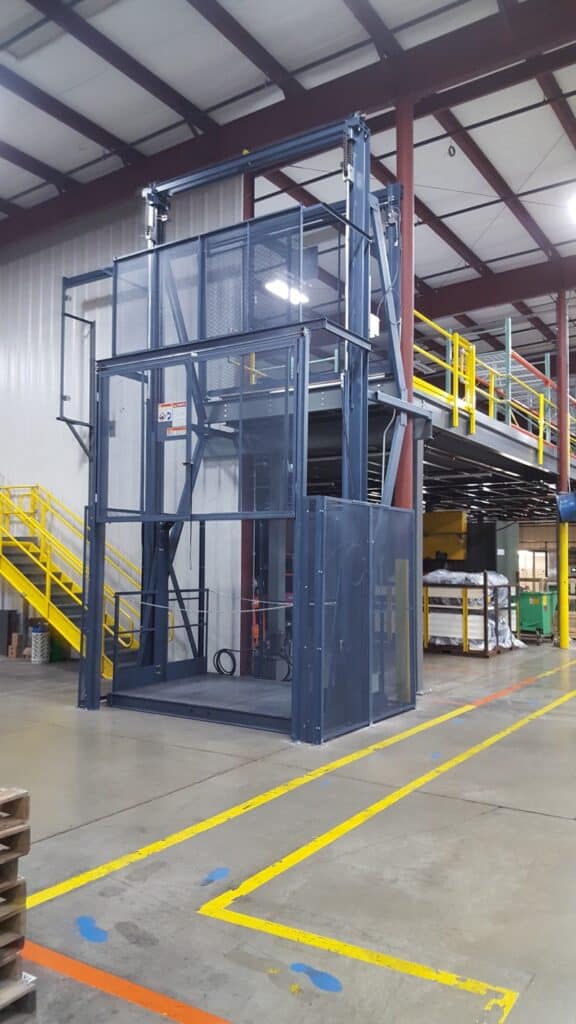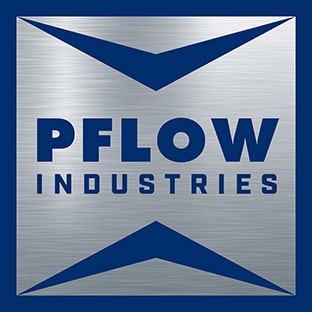
As more and more companies expand e-commerce operations to embrace next-day-delivery capabilities and direct-to-consumer (DTC) marketing models, warehouse space is becoming an increasingly precious commodity.
The Cushman & Wakefield Marketbeat Report found that U.S. industrial vacancy fell to an all-time low of just 3.2% in 2022, while average industrial rental rates hit an all-time high.
Add to that soaring labor costs and persistent post-COVID inflation spreading through already stressed supply chains and you have a seriously sticky situation in warehouses and distribution centers (DCs) from coast to coast.
Companies are responding to the crisis by:
- Optimizing floor space by building up rather than out, maximizing available floor-to-ceiling area.
- Embracing warehouse automation to reduce overall labor costs and maximize material handling efficiencies.
Mezzanine structures play an important role in both these responses, providing affordable, flexible floor space within your existing warehouse footprint. This is in addition to a surprising number of advantages for companies looking to increase storage and distribution automation.
Below, we look at how well-designed industrial mezzanines can help deliver the benefits of automation, as well as the critical role played by vertical reciprocating conveyors in providing the strong, reliable lifting capabilities needed to access mezzanines safely and effectively. Together mezzanines and VRCs hold the key to boosting storage capacity and increasing automation.
What is a Mezzanine?
A mezzanine structure is a free-standing elevated platform that sits inside your warehouse, in many cases almost doubling your available floor space. They’re often used in high-roofed warehouses where existing shelves or racks take up only some of the available vertical space.
Industrial mezzanine platforms are designed to be both strong and versatile, supporting the heaviest loads while providing accessible space that can be integrated with and expand your building's existing or planned functions.
Mezzanines also offer flexibility; their modular framework can be expanded, reconfigured, or removed as your needs change.
What is a VRC?
VRCs are industrial lifting devices built to move materials of almost any size and weight between different floor levels in a facility.
Designed to move goods, not people, VRCs do not require the same maintenance or regulatory burden as an elevator. Like mezzanines, they deliver robust, reliable lifting capabilities customized to your needs, while incorporating active and passive safety features to prevent injuries.
VRCs are powered by either hydraulic or mechanical means and can be built to lift loads from 10-200,000 lbs. They can be designed to reach almost any height and serve any number of floors. They also offer smooth travel and accurate floor leveling to protect delicate loads.
8 Benefits of Mezzanines and Automation

Although the space-saving benefits of mezzanine levels are clear, that’s only part of the puzzle. Here are eight ways in which well-designed mezzanine space can support warehouse automation.
1. Footprint Optimization
By adding vertical space, you free up prime dock-level real estate for crucial shipping, receiving, or re-packaging applications. It also allows for added automation functionality without losing on-premise premium storage space, especially in high-cost urban DCs close to valuable markets.
2. Automation Backbone
Squeezing critical automation support systems into an existing warehouse can be challenging. A mezzanine can help you position horizontal conveyor systems, hoppers, sorters, and other warehouse automation equipment right where they need to be.
3. Avoid Bottlenecks
Get the flexibility you need to optimize your automated handling systems’ layout. Designate clear zones where you need them with enough run-off space to prevent bottlenecks or manage them without shutting down the line.
4. SLAM Dunk
Going DTC? You’ll benefit by automating your Scan/Label/Apply/Manifest (SLAM) processes. Mezzanines are popular choices for adding multiple scanning and labeling stations or additional storage areas, and VRCs provide a safe and efficient way to move goods between floor levels.
5. Room to Grow
Extra space means room to grow when you start to reap the benefits of automation Keep more products on hand and get them to customers faster with extra space right where you need it.
6. Just the Space You Need
The modular design of many mezzanine platforms means you can add on just the space you need to support your automated operations, rather than having to invest in additional floor space or even relocate your entire warehouse.
7. Energy Efficiency
Optimizing the location of moving-part equipment like conveyors, sorters, and pick modules can reduce energy by shortening belt runs so you can run more than one device off a single two- or three-phase power point.
8. Capital Savings
While adding a mezzanine level is a significant investment, it can deliver major returns on investment over time, potentially paying for itself many times over by eliminating the need to invest in a larger space or completely redesign a facility.
Better Together: Mezzanines and VRCs
Mezzanine platforms have great potential to help power automation, but only if they can be accessed safely and conveniently. Fortunately, VRC technology was designed to do just that.
VRCs provide reliable, endlessly repeatable lifting performance that allows mezzanine platforms to be integrated seamlessly into warehouse workflows, whether they are manually loaded or incorporated as part of an automated conveyor- or robotic vehicle-loaded system.
Here are some more specific ways that VRCs and mezzanines work together to drive warehouse automation.
Scalability
VRCs allow materials to be stored on large or even multi-level mezzanines, boosting storage per square foot and keeping your stock easily accessible.
And, with speeds of up to 400 feet per minute and an unlimited number of cycles, VRCs can be a game changer for facility throughput, allowing you to move more material faster.
Flexibility
VRCs offer more flexibility in placement than people-moving elevators and can be customized for your specific load/unload, capacity, and lifting frequency requirements. VRCs offer tried-and-true lifting capabilities tailored to your specific needs.
Integration
VRCs can be physically integrated with almost any type of horizontal conveyor or automated guided vehicles and autonomous mobile robots. VRCs are also an integral part of complex pick systems for fulfillment operations.
VRCs can also be integrated into whole-plant warehouse management systems, enabling real-time data tracking and operational control.
Safety
Automation is no good if you cannot protect your people. That means safety gates and fail-safes to prevent a lift from moving or dropping unexpectedly, and guardrails and backstops to stop loads from being accidentally pushed off the mezzanine.
Full-height enclosures also prevent anyone on a staircase or upper level from becoming entrapped in the VRC.

Efficiency
Unlike inclined conveyors or forklifts, VRCs don’t eat up valuable floor space. Engineered to fit into the tightest corners of existing buildings, VRCs provide the upper-level access you need for storage, automation, or SLAM areas without taking up precious floor space.Read More: British Retailer Optimizes Warehouse Utilization with Pflow VRC
The Right VRC for Your Mezzanine
We’ve shown that VRCs are critical if you are using a mezzanine level to optimize space and power automation. Full automation of even a small warehouse, however, is a complex, process. How do you go about choosing VRC machinery to deliver these benefits?
Start by looking for quality equipment that meets your height, throughput, and load capacity requirements.
It’s also important to choose a supplier with a reputation for reliability and a proven track record in warehouse automation, as well as the in-house skills needed to handle the complex task of successfully integrating equipment from multiple OEMs.
You should also look for:
- Customizability: Choose equipment and a supplier that can be built to your exact specifications and needs. Only leading suppliers like PFlow can tailor equipment to your exact needs.
- Integration: Ask serious questions of your supplier. Do they know how to build equipment that integrates with your conveyors, pick modules, or autonomous systems?
- Safety: Invest now, not after an accident. Look for class-leading features and compliance with ASME B20.1 standards.
- Support: Automation is an ongoing process. Look for a partner who will deliver durable solutions and stand by them with technical support, service, and parts, so you can reap long-term returns on your automation investment
VRCs and Mezzanines: Your Automation Platform
At PFlow, we don’t build mezzanine platforms, but we do provide the critical lifting technology you need to get the most out of them. In fact, we pioneered the VRC concept itself as the original automated lifting solution, so you could say automation is in our DNA.
Today, our tough, fully customized VRCs provide access and integration day in and day out in hundreds of warehouses across the world.
Our equipment complies with ASME B20.1 and other critical safety and regulatory requirements, and we support every installation with start-up support, maintenance contracts, safety and certification inspection, and training.
Click below to learn more about our custom products and integrations.
